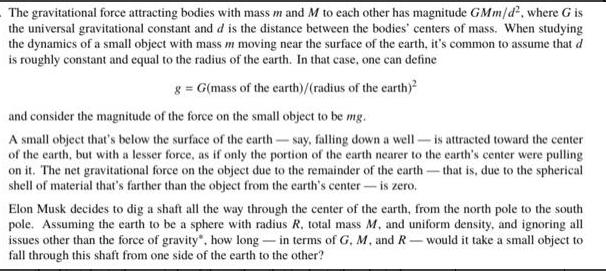Answered step by step
Verified Expert Solution
Question
1 Approved Answer
The gravitational force attracting bodies with mass m and M to each other has magnitude GMm/d, where G is the universal gravitational constant and

The gravitational force attracting bodies with mass m and M to each other has magnitude GMm/d, where G is the universal gravitational constant and d is the distance between the bodies' centers of mass. When studying the dynamics of a small object with mass m moving near the surface of the earth, it's common to assume that d is roughly constant and equal to the radius of the earth. In that case, one can define g = G(mass of the earth)/(radius of the earth) and consider the magnitude of the force on the small object to be mg. A small object that's below the surface of the earth-say, falling down a well-is attracted toward the center of the earth, but with a lesser force, as if only the portion of the earth nearer to the earth's center were pulling on it. The net gravitational force on the object due to the remainder of the earth-that is, due to the spherical shell of material that's farther than the object from the earth's center - is zero. Elon Musk decides to dig a shaft all the way through the center of the earth, from the north pole to the south pole. Assuming the earth to be a sphere with radius R, total mass M, and uniform density, and ignoring all issues other than the force of gravity", how long in terms of G, M. and R-would it take a small object to fall through this shaft from one side of the earth to the other?
Step by Step Solution
There are 3 Steps involved in it
Step: 1

Get Instant Access to Expert-Tailored Solutions
See step-by-step solutions with expert insights and AI powered tools for academic success
Step: 2

Step: 3

Ace Your Homework with AI
Get the answers you need in no time with our AI-driven, step-by-step assistance
Get Started


